Object Modelling: ATM System of Collin Bank
VerifiedAdded on 2023/06/12
|14
|2407
|414
AI Summary
This article discusses the object modelling of an ATM system for Collin Bank, including use cases and sequence diagrams. It covers user validation, cash withdrawal, and cash deposit.
Contribute Materials
Your contribution can guide someone’s learning journey. Share your
documents today.
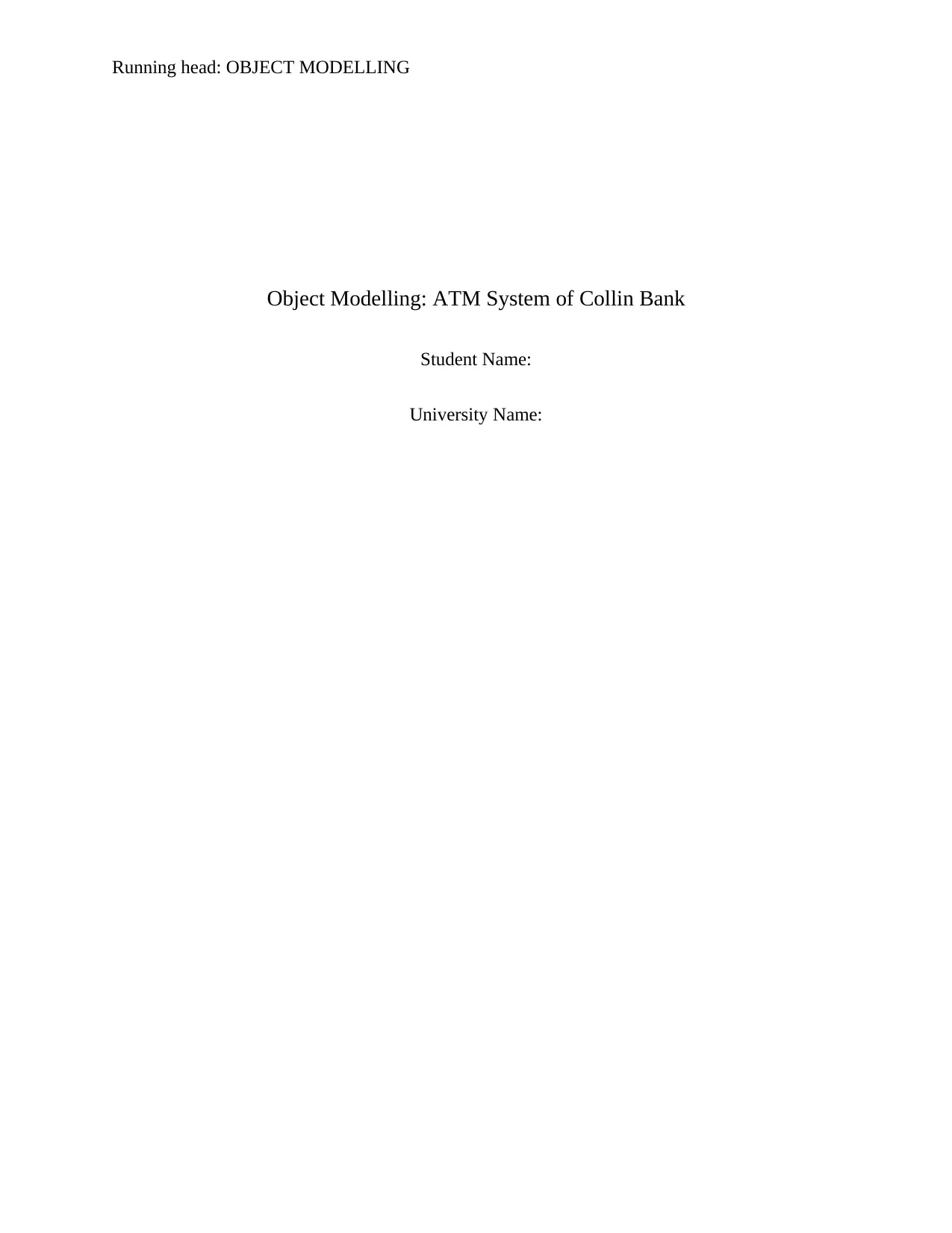
Running head: OBJECT MODELLING
Object Modelling: ATM System of Collin Bank
Student Name:
University Name:
Object Modelling: ATM System of Collin Bank
Student Name:
University Name:
Secure Best Marks with AI Grader
Need help grading? Try our AI Grader for instant feedback on your assignments.
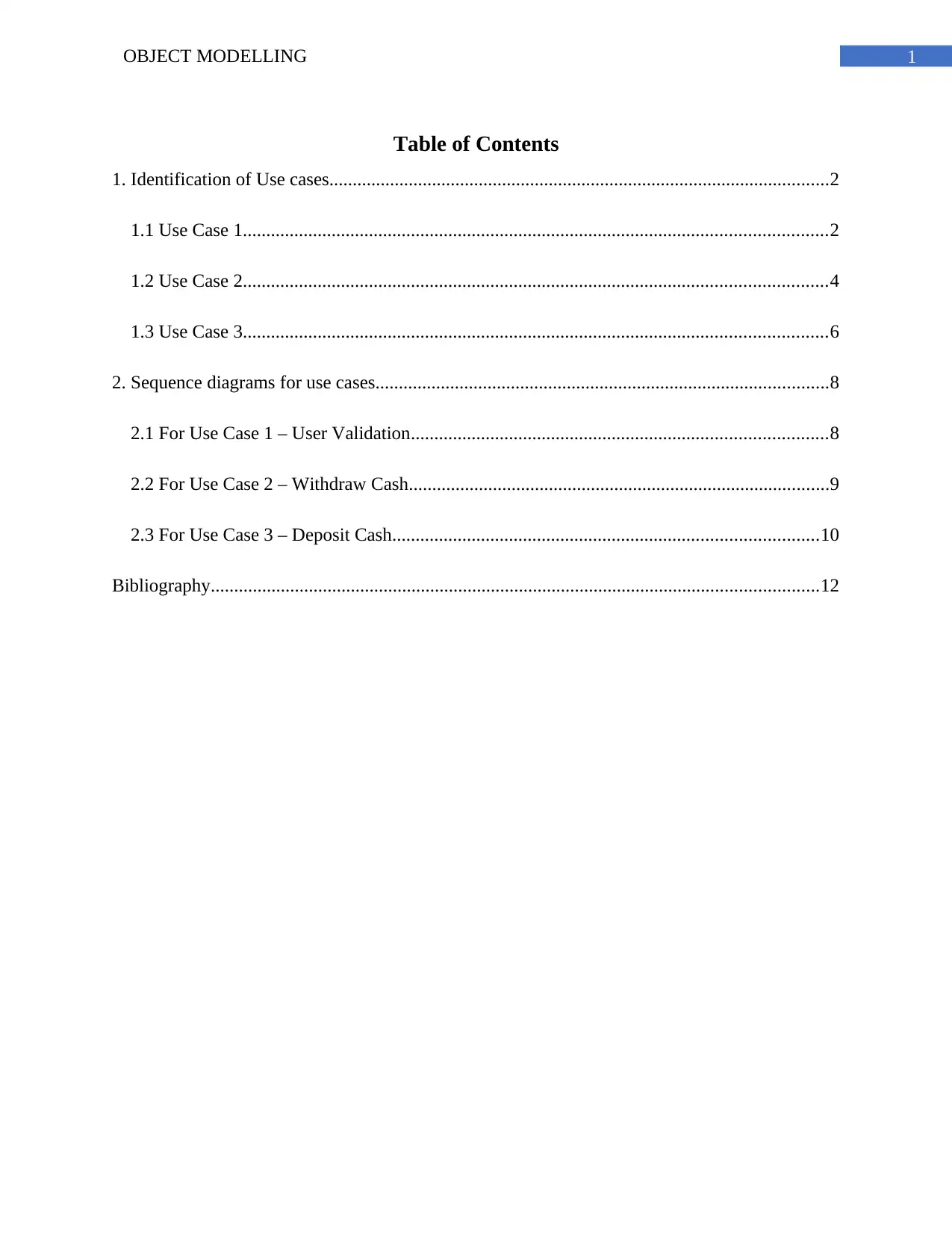
1OBJECT MODELLING
Table of Contents
1. Identification of Use cases...........................................................................................................2
1.1 Use Case 1.............................................................................................................................2
1.2 Use Case 2.............................................................................................................................4
1.3 Use Case 3.............................................................................................................................6
2. Sequence diagrams for use cases.................................................................................................8
2.1 For Use Case 1 – User Validation.........................................................................................8
2.2 For Use Case 2 – Withdraw Cash..........................................................................................9
2.3 For Use Case 3 – Deposit Cash...........................................................................................10
Bibliography..................................................................................................................................12
Table of Contents
1. Identification of Use cases...........................................................................................................2
1.1 Use Case 1.............................................................................................................................2
1.2 Use Case 2.............................................................................................................................4
1.3 Use Case 3.............................................................................................................................6
2. Sequence diagrams for use cases.................................................................................................8
2.1 For Use Case 1 – User Validation.........................................................................................8
2.2 For Use Case 2 – Withdraw Cash..........................................................................................9
2.3 For Use Case 3 – Deposit Cash...........................................................................................10
Bibliography..................................................................................................................................12
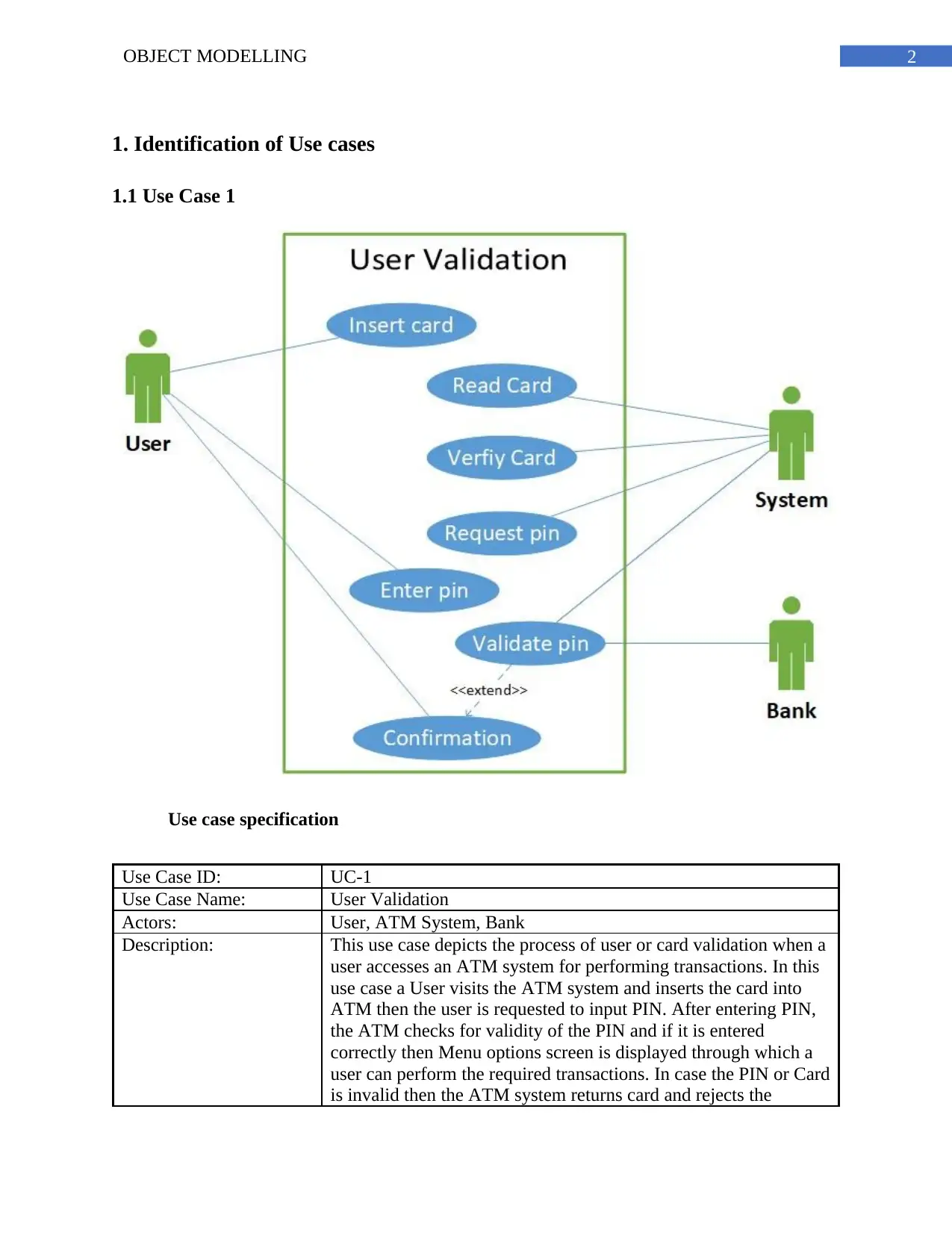
2OBJECT MODELLING
1. Identification of Use cases
1.1 Use Case 1
Use case specification
Use Case ID: UC-1
Use Case Name: User Validation
Actors: User, ATM System, Bank
Description: This use case depicts the process of user or card validation when a
user accesses an ATM system for performing transactions. In this
use case a User visits the ATM system and inserts the card into
ATM then the user is requested to input PIN. After entering PIN,
the ATM checks for validity of the PIN and if it is entered
correctly then Menu options screen is displayed through which a
user can perform the required transactions. In case the PIN or Card
is invalid then the ATM system returns card and rejects the
1. Identification of Use cases
1.1 Use Case 1
Use case specification
Use Case ID: UC-1
Use Case Name: User Validation
Actors: User, ATM System, Bank
Description: This use case depicts the process of user or card validation when a
user accesses an ATM system for performing transactions. In this
use case a User visits the ATM system and inserts the card into
ATM then the user is requested to input PIN. After entering PIN,
the ATM checks for validity of the PIN and if it is entered
correctly then Menu options screen is displayed through which a
user can perform the required transactions. In case the PIN or Card
is invalid then the ATM system returns card and rejects the
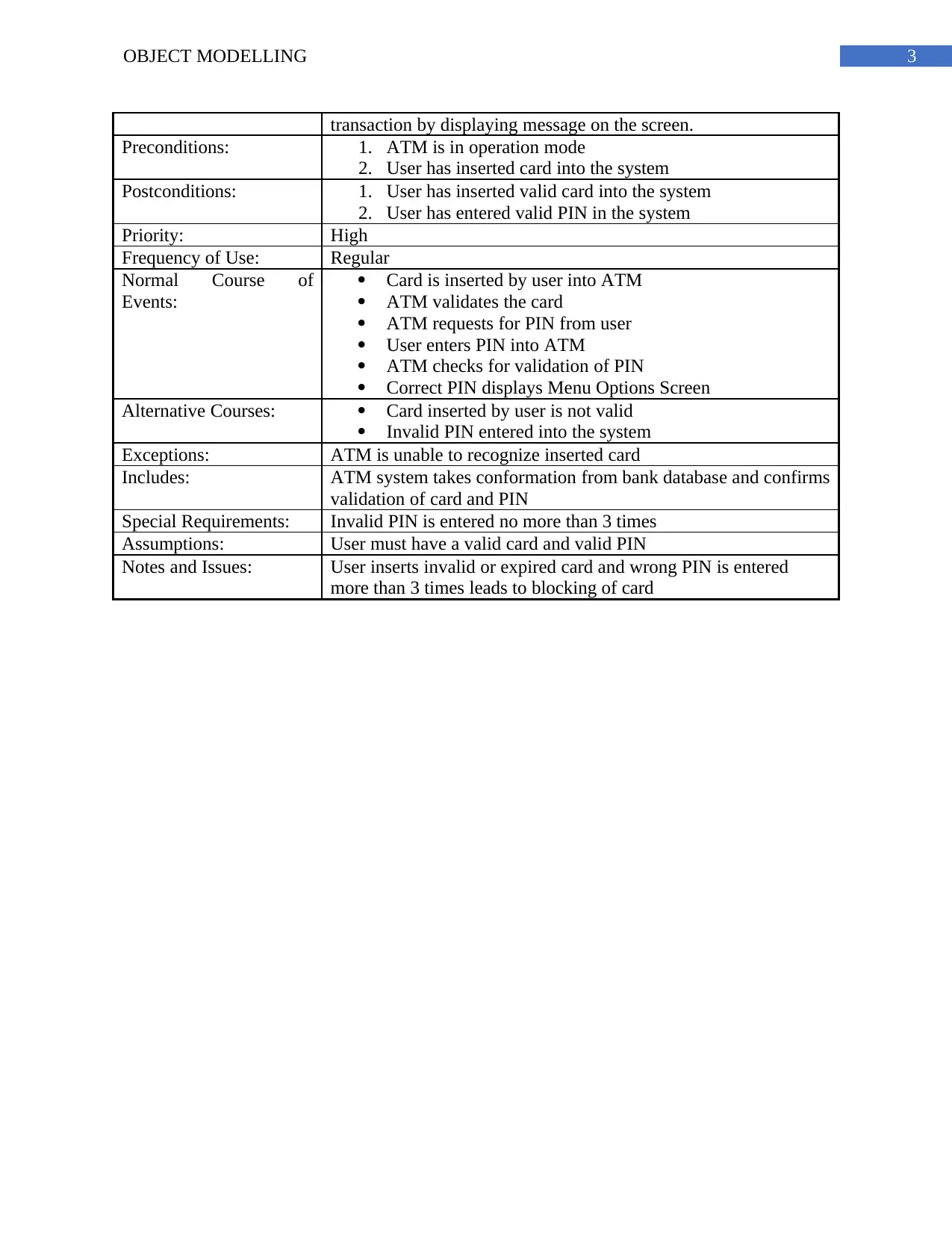
3OBJECT MODELLING
transaction by displaying message on the screen.
Preconditions: 1. ATM is in operation mode
2. User has inserted card into the system
Postconditions: 1. User has inserted valid card into the system
2. User has entered valid PIN in the system
Priority: High
Frequency of Use: Regular
Normal Course of
Events:
Card is inserted by user into ATM
ATM validates the card
ATM requests for PIN from user
User enters PIN into ATM
ATM checks for validation of PIN
Correct PIN displays Menu Options Screen
Alternative Courses: Card inserted by user is not valid
Invalid PIN entered into the system
Exceptions: ATM is unable to recognize inserted card
Includes: ATM system takes conformation from bank database and confirms
validation of card and PIN
Special Requirements: Invalid PIN is entered no more than 3 times
Assumptions: User must have a valid card and valid PIN
Notes and Issues: User inserts invalid or expired card and wrong PIN is entered
more than 3 times leads to blocking of card
transaction by displaying message on the screen.
Preconditions: 1. ATM is in operation mode
2. User has inserted card into the system
Postconditions: 1. User has inserted valid card into the system
2. User has entered valid PIN in the system
Priority: High
Frequency of Use: Regular
Normal Course of
Events:
Card is inserted by user into ATM
ATM validates the card
ATM requests for PIN from user
User enters PIN into ATM
ATM checks for validation of PIN
Correct PIN displays Menu Options Screen
Alternative Courses: Card inserted by user is not valid
Invalid PIN entered into the system
Exceptions: ATM is unable to recognize inserted card
Includes: ATM system takes conformation from bank database and confirms
validation of card and PIN
Special Requirements: Invalid PIN is entered no more than 3 times
Assumptions: User must have a valid card and valid PIN
Notes and Issues: User inserts invalid or expired card and wrong PIN is entered
more than 3 times leads to blocking of card
Secure Best Marks with AI Grader
Need help grading? Try our AI Grader for instant feedback on your assignments.
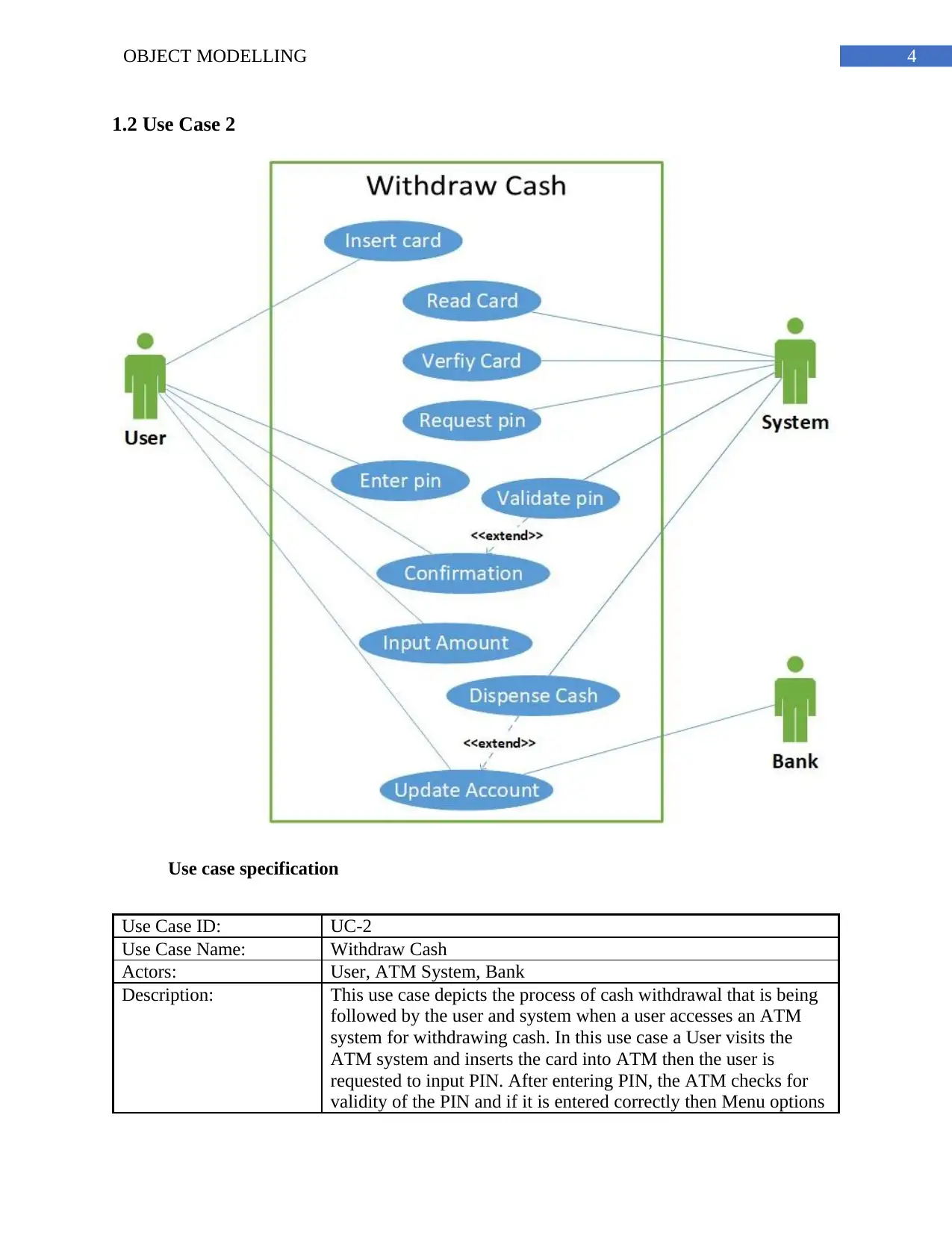
4OBJECT MODELLING
1.2 Use Case 2
Use case specification
Use Case ID: UC-2
Use Case Name: Withdraw Cash
Actors: User, ATM System, Bank
Description: This use case depicts the process of cash withdrawal that is being
followed by the user and system when a user accesses an ATM
system for withdrawing cash. In this use case a User visits the
ATM system and inserts the card into ATM then the user is
requested to input PIN. After entering PIN, the ATM checks for
validity of the PIN and if it is entered correctly then Menu options
1.2 Use Case 2
Use case specification
Use Case ID: UC-2
Use Case Name: Withdraw Cash
Actors: User, ATM System, Bank
Description: This use case depicts the process of cash withdrawal that is being
followed by the user and system when a user accesses an ATM
system for withdrawing cash. In this use case a User visits the
ATM system and inserts the card into ATM then the user is
requested to input PIN. After entering PIN, the ATM checks for
validity of the PIN and if it is entered correctly then Menu options
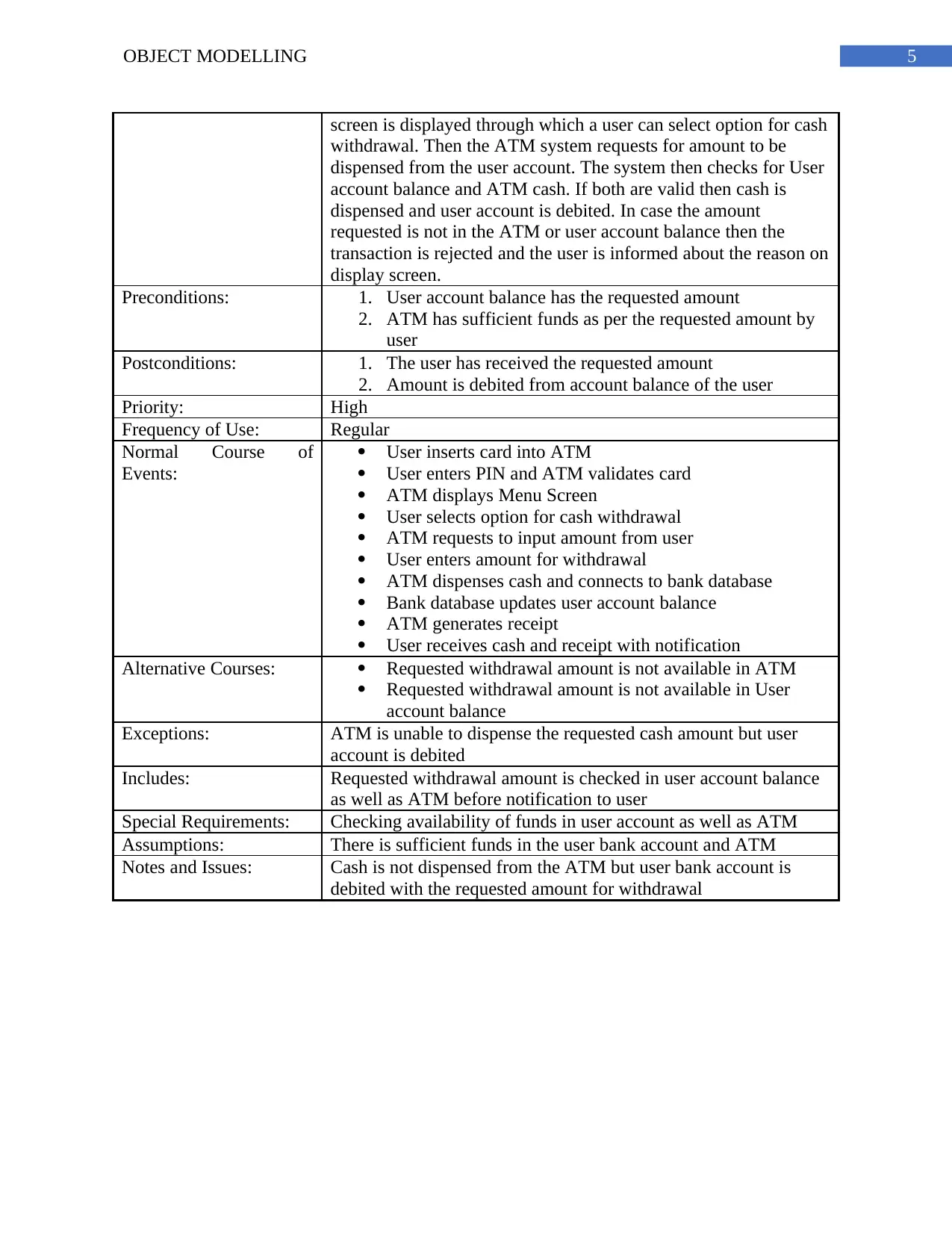
5OBJECT MODELLING
screen is displayed through which a user can select option for cash
withdrawal. Then the ATM system requests for amount to be
dispensed from the user account. The system then checks for User
account balance and ATM cash. If both are valid then cash is
dispensed and user account is debited. In case the amount
requested is not in the ATM or user account balance then the
transaction is rejected and the user is informed about the reason on
display screen.
Preconditions: 1. User account balance has the requested amount
2. ATM has sufficient funds as per the requested amount by
user
Postconditions: 1. The user has received the requested amount
2. Amount is debited from account balance of the user
Priority: High
Frequency of Use: Regular
Normal Course of
Events:
User inserts card into ATM
User enters PIN and ATM validates card
ATM displays Menu Screen
User selects option for cash withdrawal
ATM requests to input amount from user
User enters amount for withdrawal
ATM dispenses cash and connects to bank database
Bank database updates user account balance
ATM generates receipt
User receives cash and receipt with notification
Alternative Courses: Requested withdrawal amount is not available in ATM
Requested withdrawal amount is not available in User
account balance
Exceptions: ATM is unable to dispense the requested cash amount but user
account is debited
Includes: Requested withdrawal amount is checked in user account balance
as well as ATM before notification to user
Special Requirements: Checking availability of funds in user account as well as ATM
Assumptions: There is sufficient funds in the user bank account and ATM
Notes and Issues: Cash is not dispensed from the ATM but user bank account is
debited with the requested amount for withdrawal
screen is displayed through which a user can select option for cash
withdrawal. Then the ATM system requests for amount to be
dispensed from the user account. The system then checks for User
account balance and ATM cash. If both are valid then cash is
dispensed and user account is debited. In case the amount
requested is not in the ATM or user account balance then the
transaction is rejected and the user is informed about the reason on
display screen.
Preconditions: 1. User account balance has the requested amount
2. ATM has sufficient funds as per the requested amount by
user
Postconditions: 1. The user has received the requested amount
2. Amount is debited from account balance of the user
Priority: High
Frequency of Use: Regular
Normal Course of
Events:
User inserts card into ATM
User enters PIN and ATM validates card
ATM displays Menu Screen
User selects option for cash withdrawal
ATM requests to input amount from user
User enters amount for withdrawal
ATM dispenses cash and connects to bank database
Bank database updates user account balance
ATM generates receipt
User receives cash and receipt with notification
Alternative Courses: Requested withdrawal amount is not available in ATM
Requested withdrawal amount is not available in User
account balance
Exceptions: ATM is unable to dispense the requested cash amount but user
account is debited
Includes: Requested withdrawal amount is checked in user account balance
as well as ATM before notification to user
Special Requirements: Checking availability of funds in user account as well as ATM
Assumptions: There is sufficient funds in the user bank account and ATM
Notes and Issues: Cash is not dispensed from the ATM but user bank account is
debited with the requested amount for withdrawal
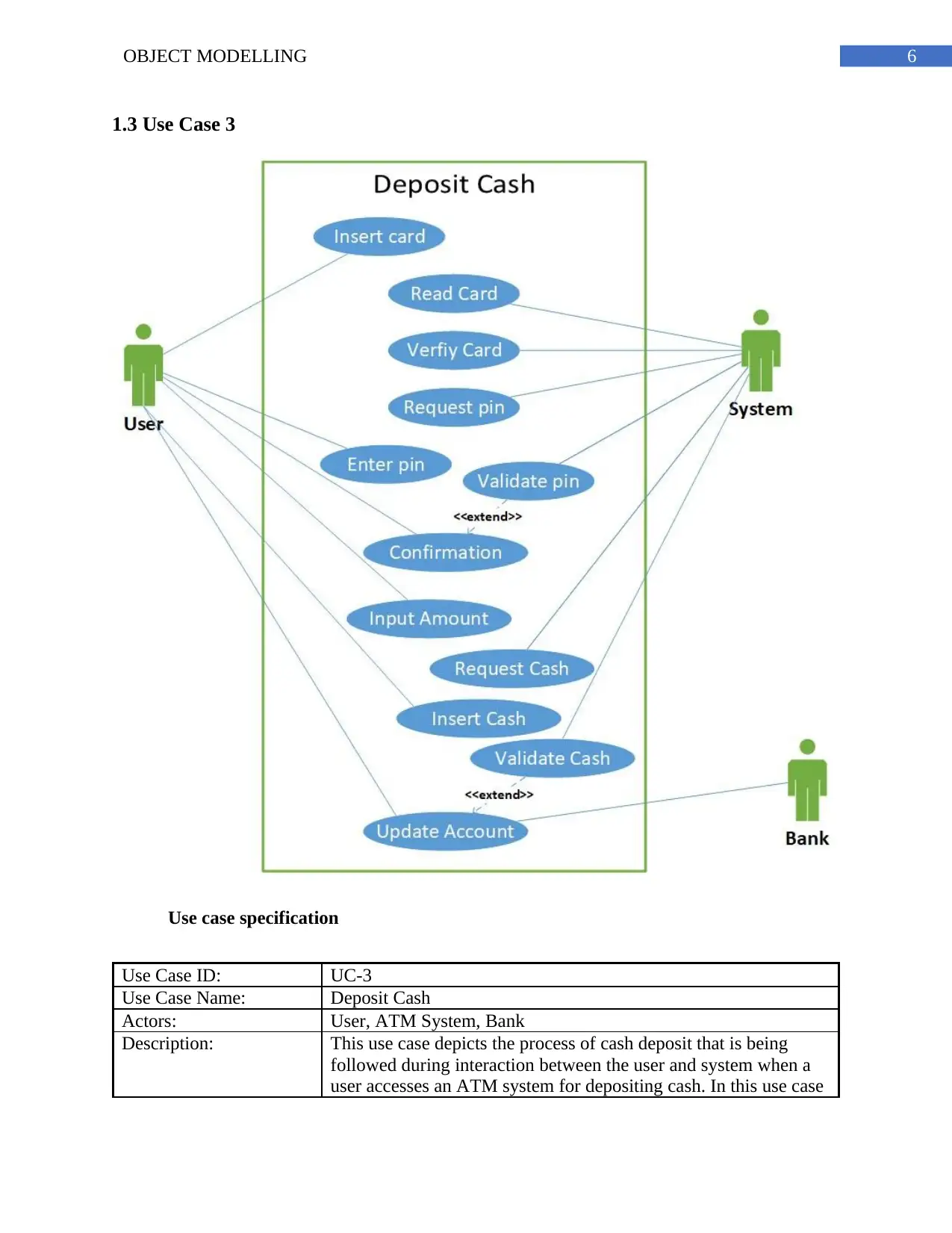
6OBJECT MODELLING
1.3 Use Case 3
Use case specification
Use Case ID: UC-3
Use Case Name: Deposit Cash
Actors: User, ATM System, Bank
Description: This use case depicts the process of cash deposit that is being
followed during interaction between the user and system when a
user accesses an ATM system for depositing cash. In this use case
1.3 Use Case 3
Use case specification
Use Case ID: UC-3
Use Case Name: Deposit Cash
Actors: User, ATM System, Bank
Description: This use case depicts the process of cash deposit that is being
followed during interaction between the user and system when a
user accesses an ATM system for depositing cash. In this use case
Paraphrase This Document
Need a fresh take? Get an instant paraphrase of this document with our AI Paraphraser
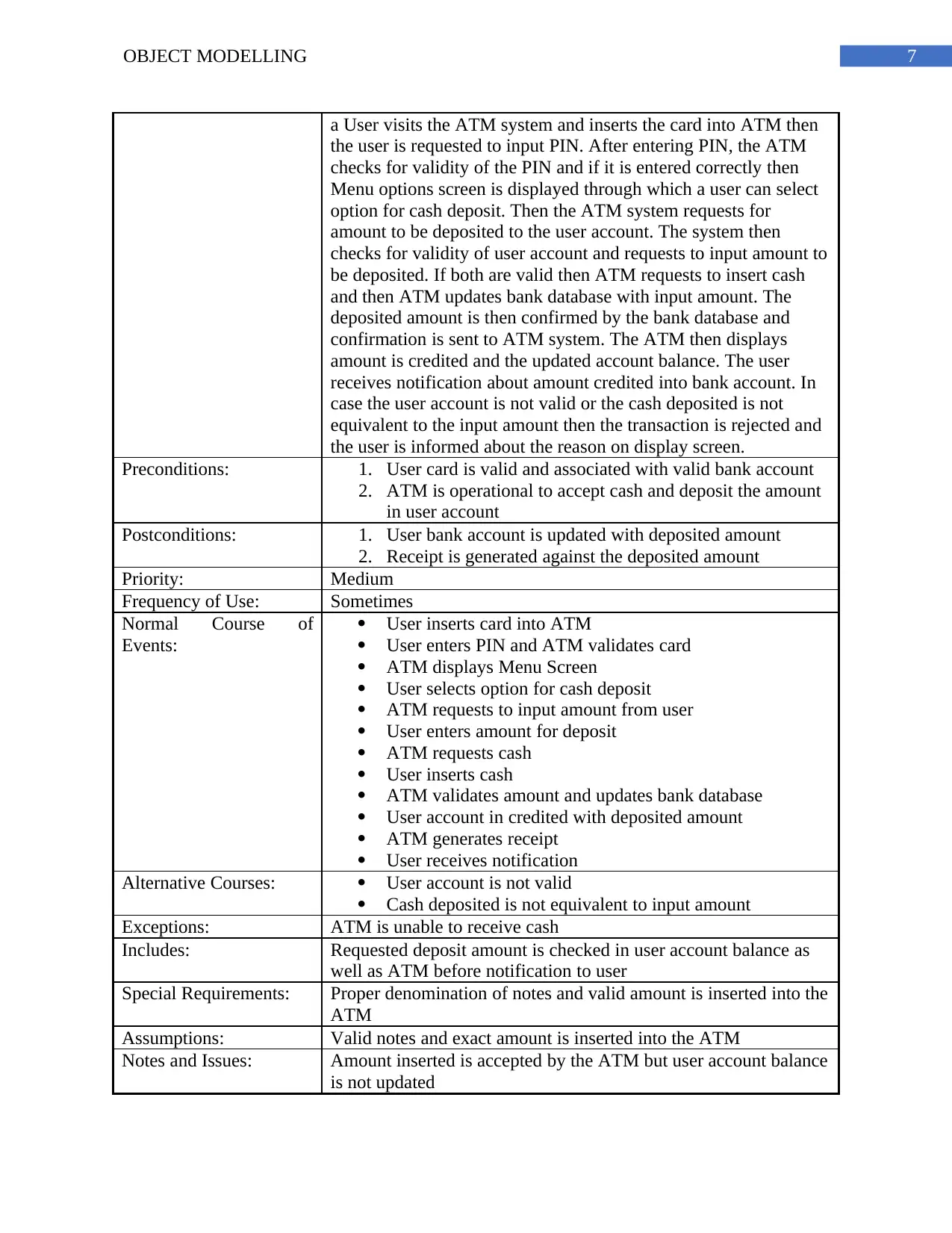
7OBJECT MODELLING
a User visits the ATM system and inserts the card into ATM then
the user is requested to input PIN. After entering PIN, the ATM
checks for validity of the PIN and if it is entered correctly then
Menu options screen is displayed through which a user can select
option for cash deposit. Then the ATM system requests for
amount to be deposited to the user account. The system then
checks for validity of user account and requests to input amount to
be deposited. If both are valid then ATM requests to insert cash
and then ATM updates bank database with input amount. The
deposited amount is then confirmed by the bank database and
confirmation is sent to ATM system. The ATM then displays
amount is credited and the updated account balance. The user
receives notification about amount credited into bank account. In
case the user account is not valid or the cash deposited is not
equivalent to the input amount then the transaction is rejected and
the user is informed about the reason on display screen.
Preconditions: 1. User card is valid and associated with valid bank account
2. ATM is operational to accept cash and deposit the amount
in user account
Postconditions: 1. User bank account is updated with deposited amount
2. Receipt is generated against the deposited amount
Priority: Medium
Frequency of Use: Sometimes
Normal Course of
Events:
User inserts card into ATM
User enters PIN and ATM validates card
ATM displays Menu Screen
User selects option for cash deposit
ATM requests to input amount from user
User enters amount for deposit
ATM requests cash
User inserts cash
ATM validates amount and updates bank database
User account in credited with deposited amount
ATM generates receipt
User receives notification
Alternative Courses: User account is not valid
Cash deposited is not equivalent to input amount
Exceptions: ATM is unable to receive cash
Includes: Requested deposit amount is checked in user account balance as
well as ATM before notification to user
Special Requirements: Proper denomination of notes and valid amount is inserted into the
ATM
Assumptions: Valid notes and exact amount is inserted into the ATM
Notes and Issues: Amount inserted is accepted by the ATM but user account balance
is not updated
a User visits the ATM system and inserts the card into ATM then
the user is requested to input PIN. After entering PIN, the ATM
checks for validity of the PIN and if it is entered correctly then
Menu options screen is displayed through which a user can select
option for cash deposit. Then the ATM system requests for
amount to be deposited to the user account. The system then
checks for validity of user account and requests to input amount to
be deposited. If both are valid then ATM requests to insert cash
and then ATM updates bank database with input amount. The
deposited amount is then confirmed by the bank database and
confirmation is sent to ATM system. The ATM then displays
amount is credited and the updated account balance. The user
receives notification about amount credited into bank account. In
case the user account is not valid or the cash deposited is not
equivalent to the input amount then the transaction is rejected and
the user is informed about the reason on display screen.
Preconditions: 1. User card is valid and associated with valid bank account
2. ATM is operational to accept cash and deposit the amount
in user account
Postconditions: 1. User bank account is updated with deposited amount
2. Receipt is generated against the deposited amount
Priority: Medium
Frequency of Use: Sometimes
Normal Course of
Events:
User inserts card into ATM
User enters PIN and ATM validates card
ATM displays Menu Screen
User selects option for cash deposit
ATM requests to input amount from user
User enters amount for deposit
ATM requests cash
User inserts cash
ATM validates amount and updates bank database
User account in credited with deposited amount
ATM generates receipt
User receives notification
Alternative Courses: User account is not valid
Cash deposited is not equivalent to input amount
Exceptions: ATM is unable to receive cash
Includes: Requested deposit amount is checked in user account balance as
well as ATM before notification to user
Special Requirements: Proper denomination of notes and valid amount is inserted into the
ATM
Assumptions: Valid notes and exact amount is inserted into the ATM
Notes and Issues: Amount inserted is accepted by the ATM but user account balance
is not updated
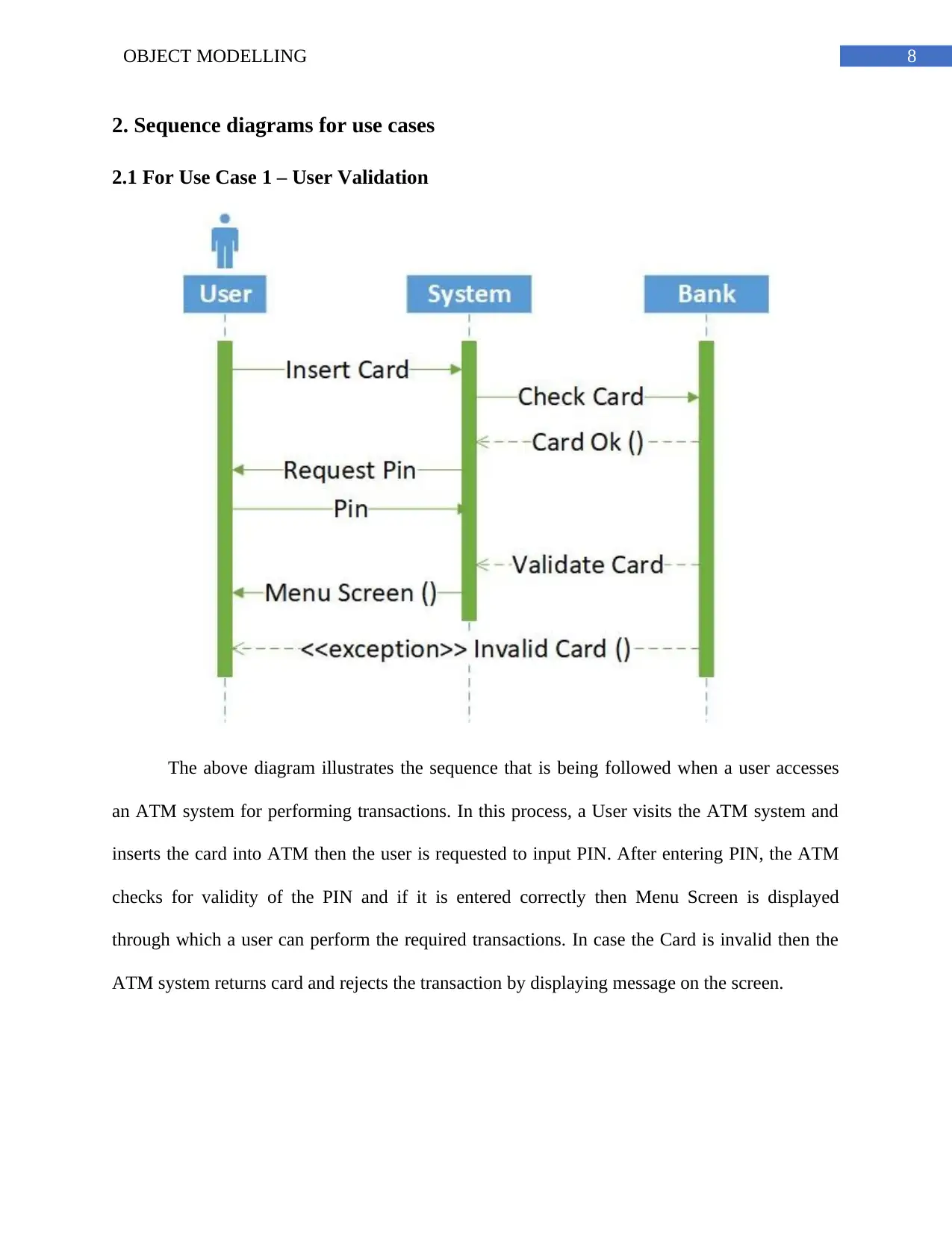
8OBJECT MODELLING
2. Sequence diagrams for use cases
2.1 For Use Case 1 – User Validation
The above diagram illustrates the sequence that is being followed when a user accesses
an ATM system for performing transactions. In this process, a User visits the ATM system and
inserts the card into ATM then the user is requested to input PIN. After entering PIN, the ATM
checks for validity of the PIN and if it is entered correctly then Menu Screen is displayed
through which a user can perform the required transactions. In case the Card is invalid then the
ATM system returns card and rejects the transaction by displaying message on the screen.
2. Sequence diagrams for use cases
2.1 For Use Case 1 – User Validation
The above diagram illustrates the sequence that is being followed when a user accesses
an ATM system for performing transactions. In this process, a User visits the ATM system and
inserts the card into ATM then the user is requested to input PIN. After entering PIN, the ATM
checks for validity of the PIN and if it is entered correctly then Menu Screen is displayed
through which a user can perform the required transactions. In case the Card is invalid then the
ATM system returns card and rejects the transaction by displaying message on the screen.
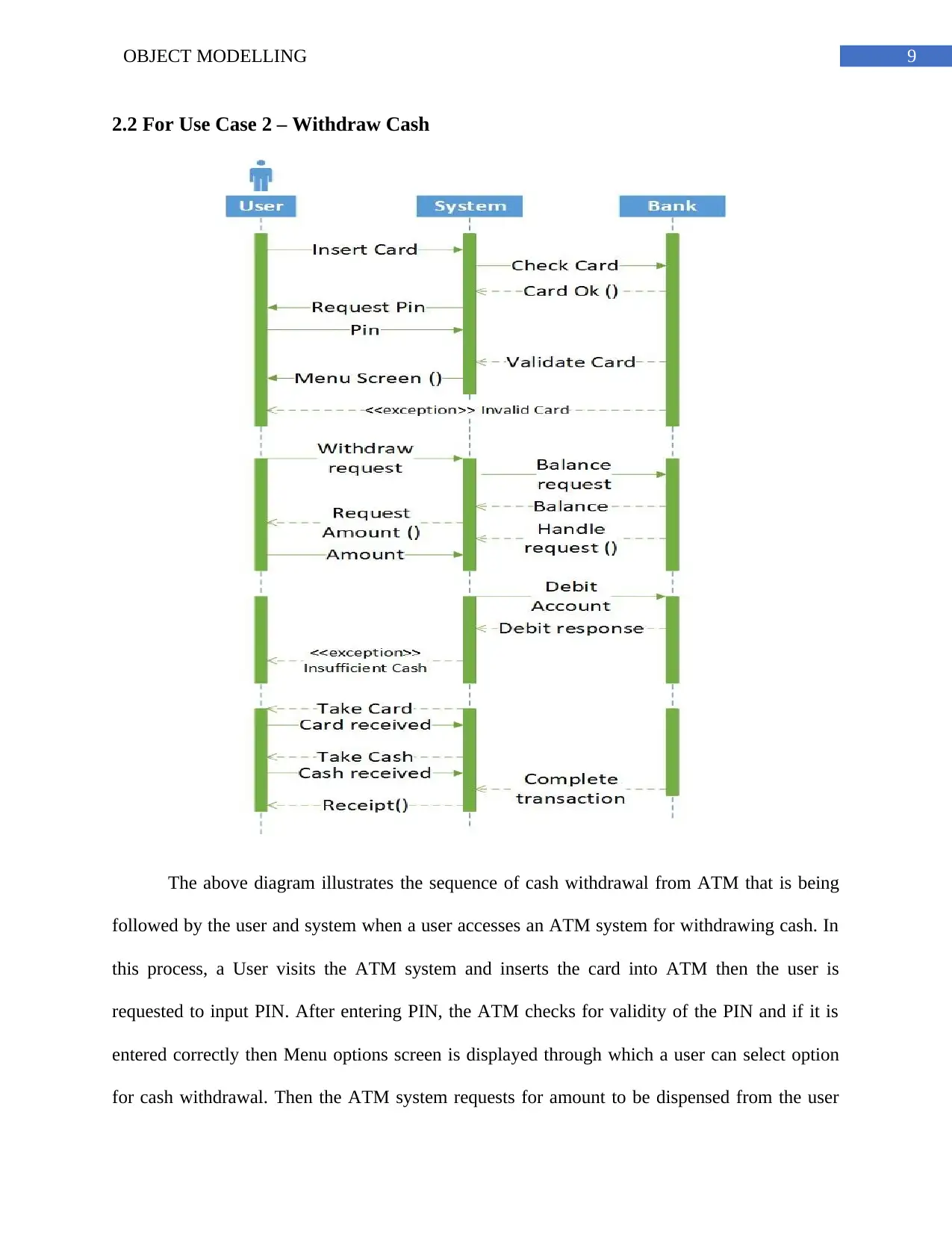
9OBJECT MODELLING
2.2 For Use Case 2 – Withdraw Cash
The above diagram illustrates the sequence of cash withdrawal from ATM that is being
followed by the user and system when a user accesses an ATM system for withdrawing cash. In
this process, a User visits the ATM system and inserts the card into ATM then the user is
requested to input PIN. After entering PIN, the ATM checks for validity of the PIN and if it is
entered correctly then Menu options screen is displayed through which a user can select option
for cash withdrawal. Then the ATM system requests for amount to be dispensed from the user
2.2 For Use Case 2 – Withdraw Cash
The above diagram illustrates the sequence of cash withdrawal from ATM that is being
followed by the user and system when a user accesses an ATM system for withdrawing cash. In
this process, a User visits the ATM system and inserts the card into ATM then the user is
requested to input PIN. After entering PIN, the ATM checks for validity of the PIN and if it is
entered correctly then Menu options screen is displayed through which a user can select option
for cash withdrawal. Then the ATM system requests for amount to be dispensed from the user
Secure Best Marks with AI Grader
Need help grading? Try our AI Grader for instant feedback on your assignments.
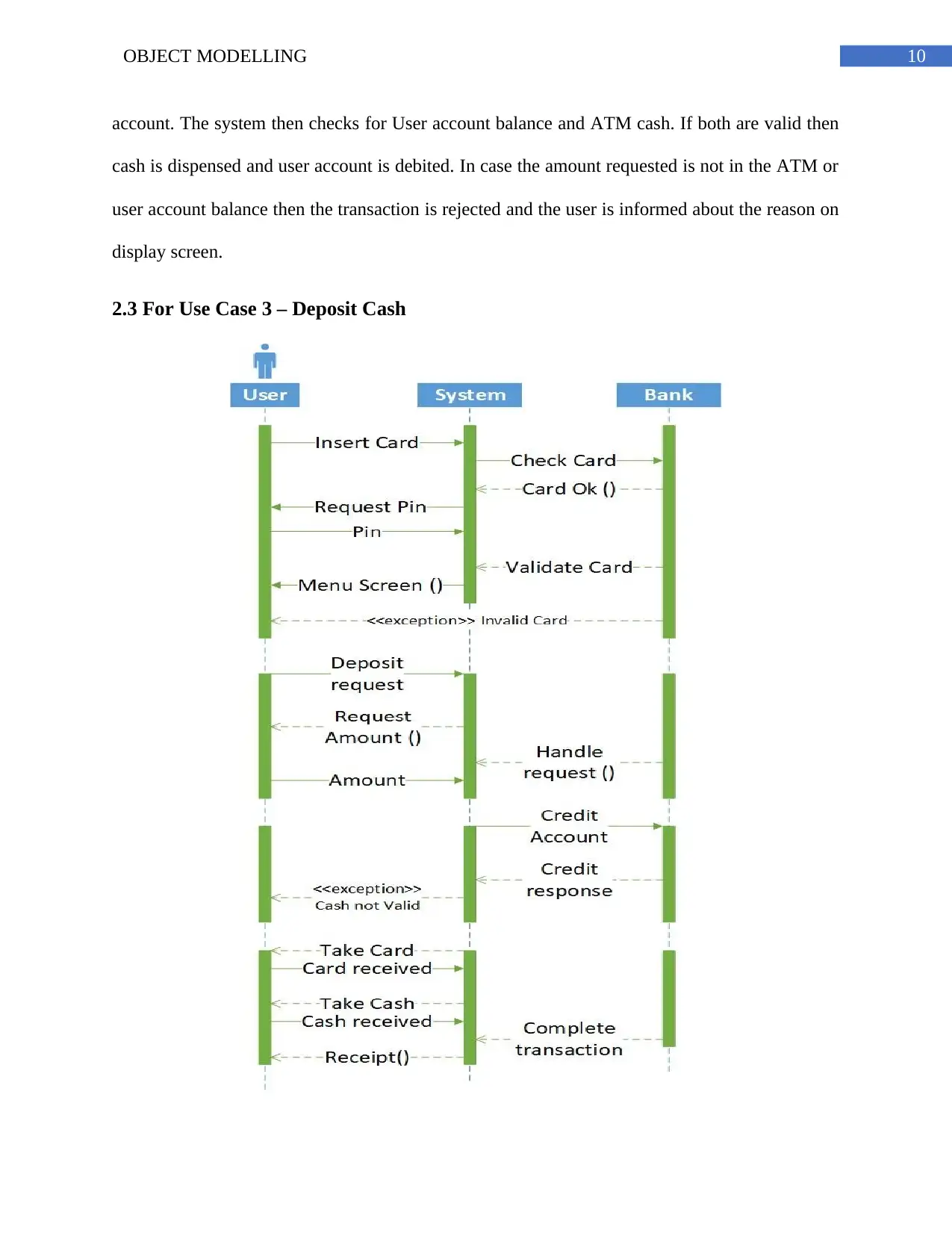
10OBJECT MODELLING
account. The system then checks for User account balance and ATM cash. If both are valid then
cash is dispensed and user account is debited. In case the amount requested is not in the ATM or
user account balance then the transaction is rejected and the user is informed about the reason on
display screen.
2.3 For Use Case 3 – Deposit Cash
account. The system then checks for User account balance and ATM cash. If both are valid then
cash is dispensed and user account is debited. In case the amount requested is not in the ATM or
user account balance then the transaction is rejected and the user is informed about the reason on
display screen.
2.3 For Use Case 3 – Deposit Cash
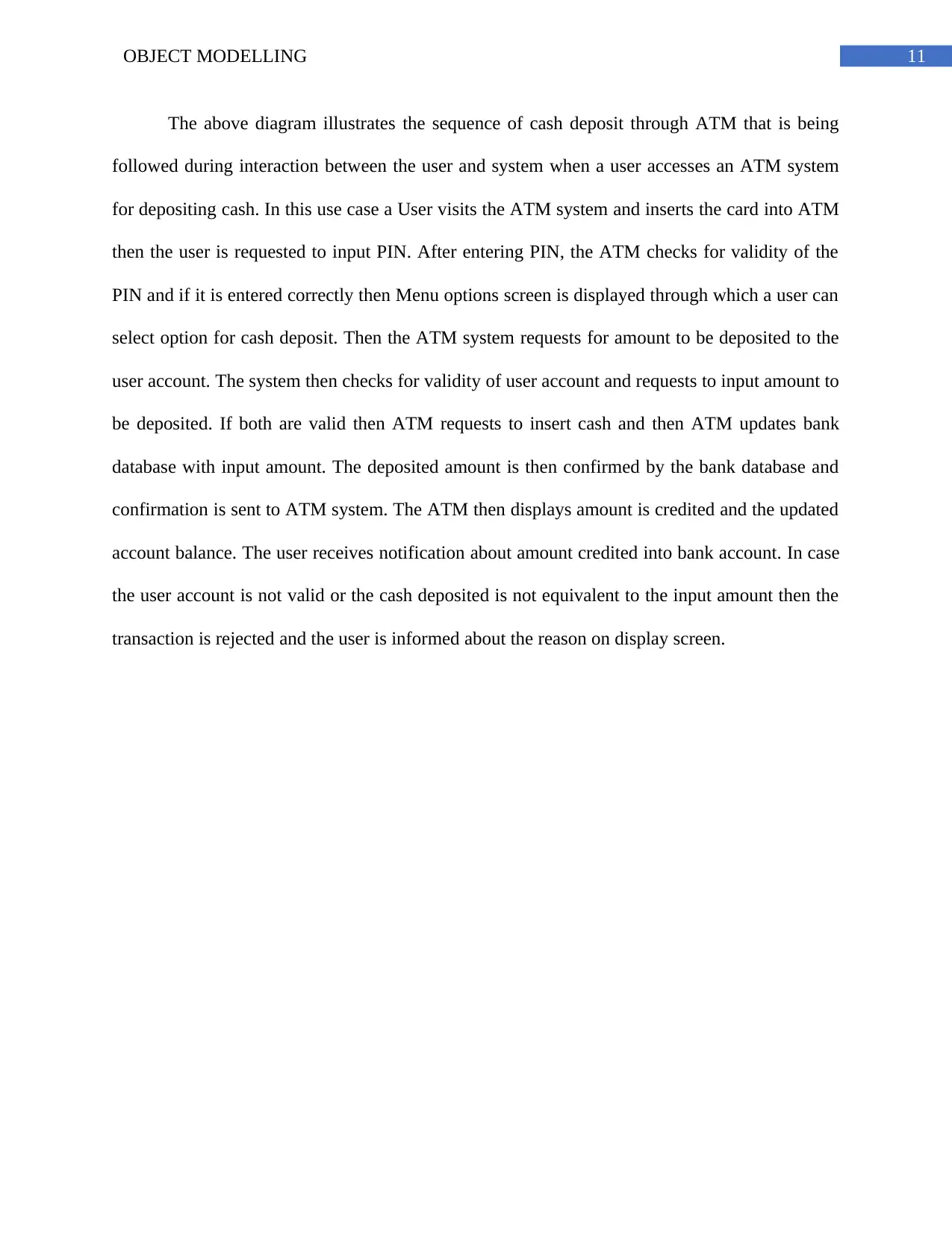
11OBJECT MODELLING
The above diagram illustrates the sequence of cash deposit through ATM that is being
followed during interaction between the user and system when a user accesses an ATM system
for depositing cash. In this use case a User visits the ATM system and inserts the card into ATM
then the user is requested to input PIN. After entering PIN, the ATM checks for validity of the
PIN and if it is entered correctly then Menu options screen is displayed through which a user can
select option for cash deposit. Then the ATM system requests for amount to be deposited to the
user account. The system then checks for validity of user account and requests to input amount to
be deposited. If both are valid then ATM requests to insert cash and then ATM updates bank
database with input amount. The deposited amount is then confirmed by the bank database and
confirmation is sent to ATM system. The ATM then displays amount is credited and the updated
account balance. The user receives notification about amount credited into bank account. In case
the user account is not valid or the cash deposited is not equivalent to the input amount then the
transaction is rejected and the user is informed about the reason on display screen.
The above diagram illustrates the sequence of cash deposit through ATM that is being
followed during interaction between the user and system when a user accesses an ATM system
for depositing cash. In this use case a User visits the ATM system and inserts the card into ATM
then the user is requested to input PIN. After entering PIN, the ATM checks for validity of the
PIN and if it is entered correctly then Menu options screen is displayed through which a user can
select option for cash deposit. Then the ATM system requests for amount to be deposited to the
user account. The system then checks for validity of user account and requests to input amount to
be deposited. If both are valid then ATM requests to insert cash and then ATM updates bank
database with input amount. The deposited amount is then confirmed by the bank database and
confirmation is sent to ATM system. The ATM then displays amount is credited and the updated
account balance. The user receives notification about amount credited into bank account. In case
the user account is not valid or the cash deposited is not equivalent to the input amount then the
transaction is rejected and the user is informed about the reason on display screen.
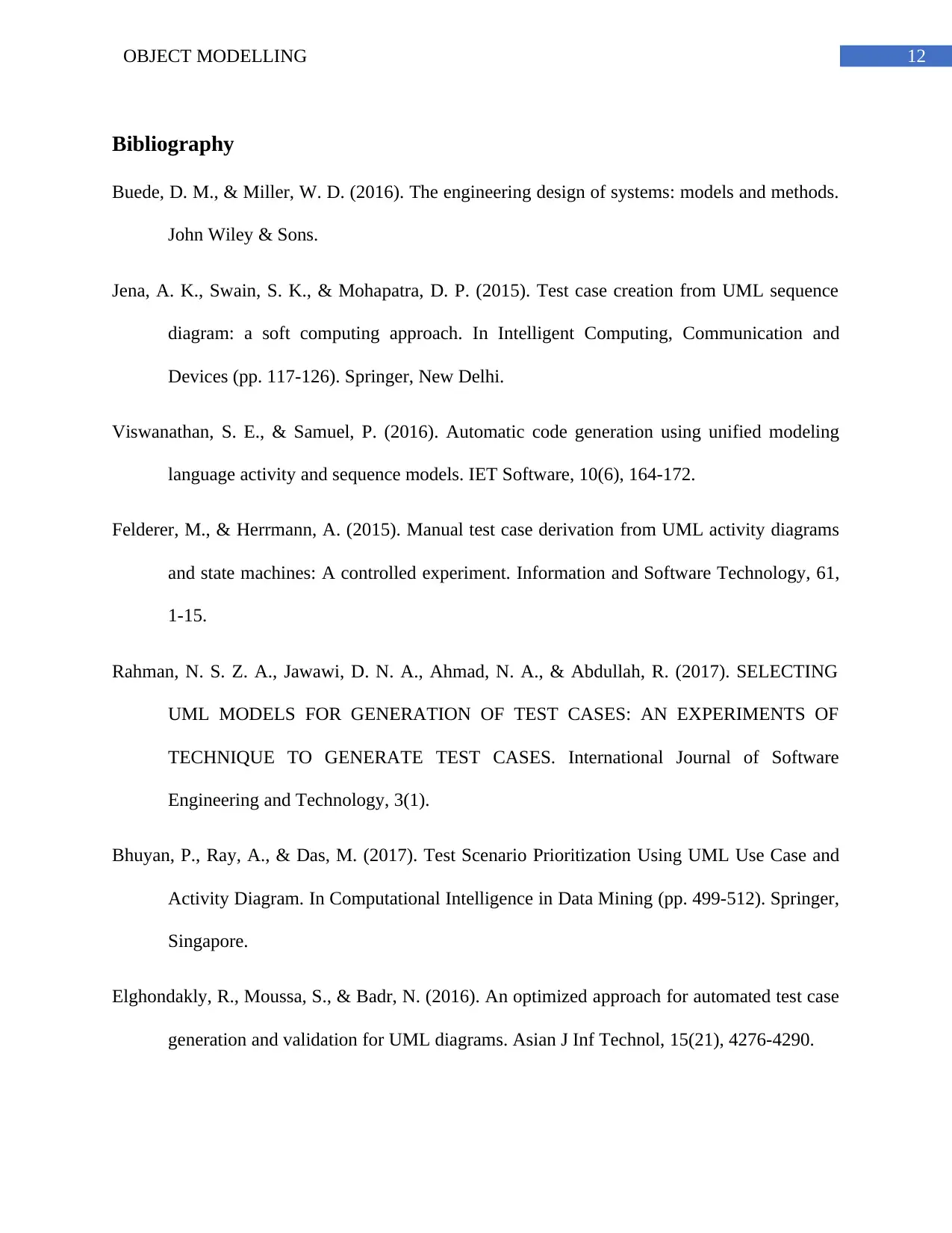
12OBJECT MODELLING
Bibliography
Buede, D. M., & Miller, W. D. (2016). The engineering design of systems: models and methods.
John Wiley & Sons.
Jena, A. K., Swain, S. K., & Mohapatra, D. P. (2015). Test case creation from UML sequence
diagram: a soft computing approach. In Intelligent Computing, Communication and
Devices (pp. 117-126). Springer, New Delhi.
Viswanathan, S. E., & Samuel, P. (2016). Automatic code generation using unified modeling
language activity and sequence models. IET Software, 10(6), 164-172.
Felderer, M., & Herrmann, A. (2015). Manual test case derivation from UML activity diagrams
and state machines: A controlled experiment. Information and Software Technology, 61,
1-15.
Rahman, N. S. Z. A., Jawawi, D. N. A., Ahmad, N. A., & Abdullah, R. (2017). SELECTING
UML MODELS FOR GENERATION OF TEST CASES: AN EXPERIMENTS OF
TECHNIQUE TO GENERATE TEST CASES. International Journal of Software
Engineering and Technology, 3(1).
Bhuyan, P., Ray, A., & Das, M. (2017). Test Scenario Prioritization Using UML Use Case and
Activity Diagram. In Computational Intelligence in Data Mining (pp. 499-512). Springer,
Singapore.
Elghondakly, R., Moussa, S., & Badr, N. (2016). An optimized approach for automated test case
generation and validation for UML diagrams. Asian J Inf Technol, 15(21), 4276-4290.
Bibliography
Buede, D. M., & Miller, W. D. (2016). The engineering design of systems: models and methods.
John Wiley & Sons.
Jena, A. K., Swain, S. K., & Mohapatra, D. P. (2015). Test case creation from UML sequence
diagram: a soft computing approach. In Intelligent Computing, Communication and
Devices (pp. 117-126). Springer, New Delhi.
Viswanathan, S. E., & Samuel, P. (2016). Automatic code generation using unified modeling
language activity and sequence models. IET Software, 10(6), 164-172.
Felderer, M., & Herrmann, A. (2015). Manual test case derivation from UML activity diagrams
and state machines: A controlled experiment. Information and Software Technology, 61,
1-15.
Rahman, N. S. Z. A., Jawawi, D. N. A., Ahmad, N. A., & Abdullah, R. (2017). SELECTING
UML MODELS FOR GENERATION OF TEST CASES: AN EXPERIMENTS OF
TECHNIQUE TO GENERATE TEST CASES. International Journal of Software
Engineering and Technology, 3(1).
Bhuyan, P., Ray, A., & Das, M. (2017). Test Scenario Prioritization Using UML Use Case and
Activity Diagram. In Computational Intelligence in Data Mining (pp. 499-512). Springer,
Singapore.
Elghondakly, R., Moussa, S., & Badr, N. (2016). An optimized approach for automated test case
generation and validation for UML diagrams. Asian J Inf Technol, 15(21), 4276-4290.
Paraphrase This Document
Need a fresh take? Get an instant paraphrase of this document with our AI Paraphraser
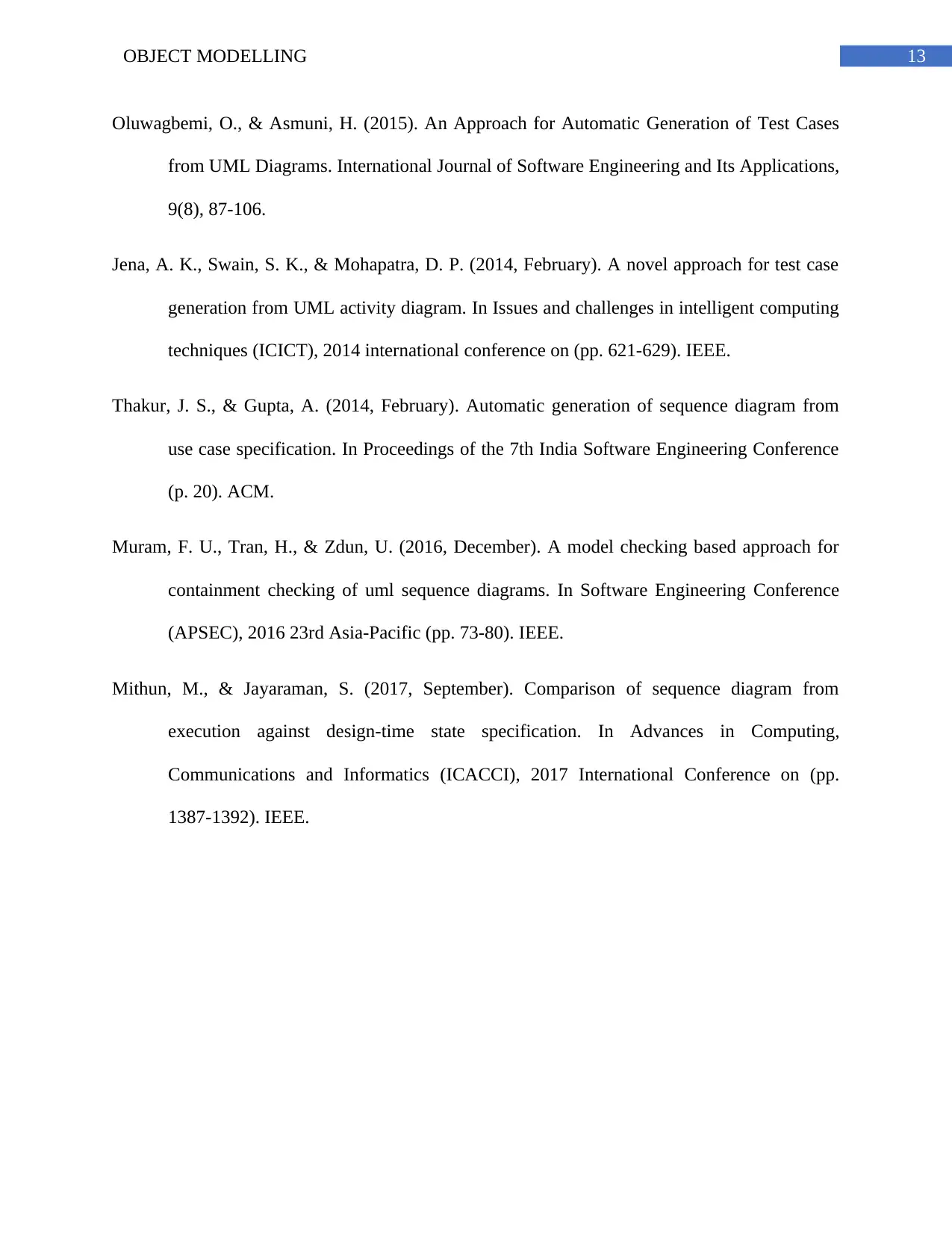
13OBJECT MODELLING
Oluwagbemi, O., & Asmuni, H. (2015). An Approach for Automatic Generation of Test Cases
from UML Diagrams. International Journal of Software Engineering and Its Applications,
9(8), 87-106.
Jena, A. K., Swain, S. K., & Mohapatra, D. P. (2014, February). A novel approach for test case
generation from UML activity diagram. In Issues and challenges in intelligent computing
techniques (ICICT), 2014 international conference on (pp. 621-629). IEEE.
Thakur, J. S., & Gupta, A. (2014, February). Automatic generation of sequence diagram from
use case specification. In Proceedings of the 7th India Software Engineering Conference
(p. 20). ACM.
Muram, F. U., Tran, H., & Zdun, U. (2016, December). A model checking based approach for
containment checking of uml sequence diagrams. In Software Engineering Conference
(APSEC), 2016 23rd Asia-Pacific (pp. 73-80). IEEE.
Mithun, M., & Jayaraman, S. (2017, September). Comparison of sequence diagram from
execution against design-time state specification. In Advances in Computing,
Communications and Informatics (ICACCI), 2017 International Conference on (pp.
1387-1392). IEEE.
Oluwagbemi, O., & Asmuni, H. (2015). An Approach for Automatic Generation of Test Cases
from UML Diagrams. International Journal of Software Engineering and Its Applications,
9(8), 87-106.
Jena, A. K., Swain, S. K., & Mohapatra, D. P. (2014, February). A novel approach for test case
generation from UML activity diagram. In Issues and challenges in intelligent computing
techniques (ICICT), 2014 international conference on (pp. 621-629). IEEE.
Thakur, J. S., & Gupta, A. (2014, February). Automatic generation of sequence diagram from
use case specification. In Proceedings of the 7th India Software Engineering Conference
(p. 20). ACM.
Muram, F. U., Tran, H., & Zdun, U. (2016, December). A model checking based approach for
containment checking of uml sequence diagrams. In Software Engineering Conference
(APSEC), 2016 23rd Asia-Pacific (pp. 73-80). IEEE.
Mithun, M., & Jayaraman, S. (2017, September). Comparison of sequence diagram from
execution against design-time state specification. In Advances in Computing,
Communications and Informatics (ICACCI), 2017 International Conference on (pp.
1387-1392). IEEE.
1 out of 14
Related Documents
Your All-in-One AI-Powered Toolkit for Academic Success.
+13062052269
info@desklib.com
Available 24*7 on WhatsApp / Email
![[object Object]](/_next/static/media/star-bottom.7253800d.svg)
Unlock your academic potential
© 2024 | Zucol Services PVT LTD | All rights reserved.



